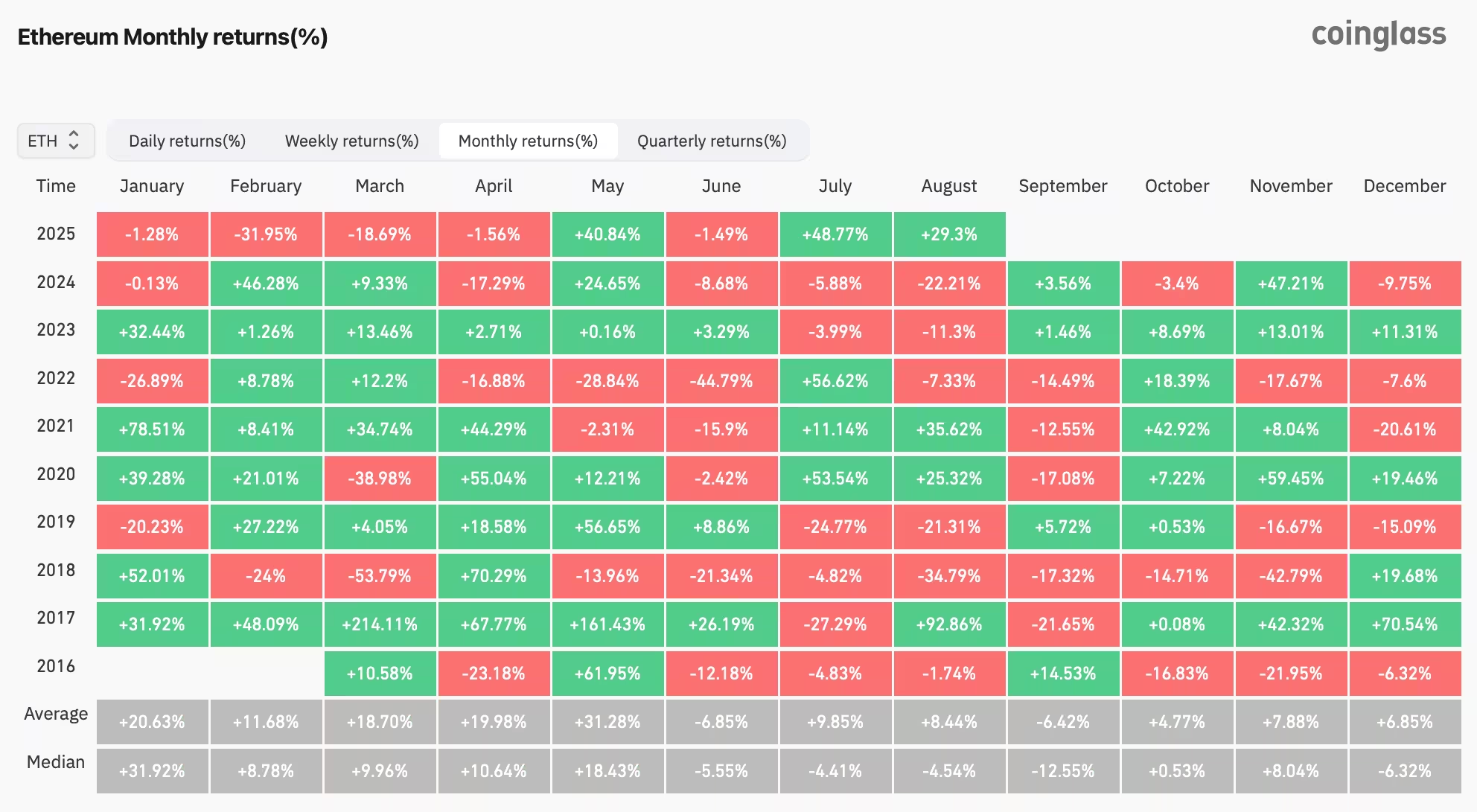3 Minutes
August strength for Ether contrasts with historical September weakness
Ether has surged through August, climbing roughly 25% since the month began as investors rotated capital into Ethereum and related products. At publication, ETH trades near $4,759 — up about $952 from its August 1 open of $3,807 — and briefly pierced $4,867 after dovish comments from Federal Reserve Chair Jerome Powell at the Jackson Hole symposium. While those macro signals and ETF flows have supported bullish momentum, historical seasonality raises a flag for September.
Seasonality data and past pullbacks
On-chain and market analytics show a recurring pattern: since 2016, whenever Ether posted gains in August, September often brought a correction. CoinGlass data highlights three clear examples. In 2017 ETH surged 92.86% in August and then fell 21.65% in September. The same cadence appeared in 2020 (August +25.32%; September -17.08%) and 2021 (August +35.62%; September -12.55%). That track record has traders urging caution despite current bullish catalysts.
Why this September might differ
There are several structural differences this year that could blunt a typical seasonal pullback. Most notably, spot Ether ETFs have attracted substantial inflows in August, and corporate crypto treasuries now hold more ETH than at any recent comparable rally.
ETF flows and treasury accumulation
Spot Ether ETFs recorded roughly $2.79 billion in net inflows during August, according to Farside, while spot Bitcoin ETFs simultaneously saw about $1.2 billion in net outflows. NovaDius Wealth Management president Nate Geraci has noted a "notable shift" from BTC to ETH ETF inflows — a change that could support price stability or reduce the depth of any typical September retracement.
Corporate demand is another differentiator. On Aug. 11, total Ether held by companies with crypto treasuries surpassed $13 billion in value. Arkham reported that BitMine chairman Tom Lee purchased an additional $45 million of ETH for the firm, bringing BitMine’s reported stack to about $7 billion. These concentrated institutional positions can provide a liquidity floor that didn’t exist in prior seasonal cycles.

Macro backdrop and trader implications
Jerome Powell’s hints toward a potential interest-rate cut have been interpreted as a bullish macro catalyst for risk assets, including cryptocurrencies. Yet history suggests traders should monitor the calendar and be prepared for volatility in September. Seasonality is not destiny, but it is a useful risk-management input.
Key indicators to watch
- ETF flows: Continued net inflows into spot Ether ETFs could sustain upward pressure.
- Corporate treasury accumulation: Growing ETH reserves at publicly known firms may reduce available supply.
- Macro signals: Fed guidance, inflation data, and Treasury yields will sway crypto risk appetite.
- Bitcoin dominance: BTC dominance has fallen about 5.88% over the past 30 days to 58.19%, a sign that capital is rotating into altcoins and broader crypto markets.
Traders and investors should balance historical seasonality with the new structural forces at work this year. While past August gains preceded September pullbacks, unprecedented ETF adoption and sizable corporate treasuries mean this cycle could play out differently. Prudence, position sizing, and keeping an eye on ETF inflows and macro updates remain essential for navigating potential September volatility.
Source: cointelegraph


Leave a Comment